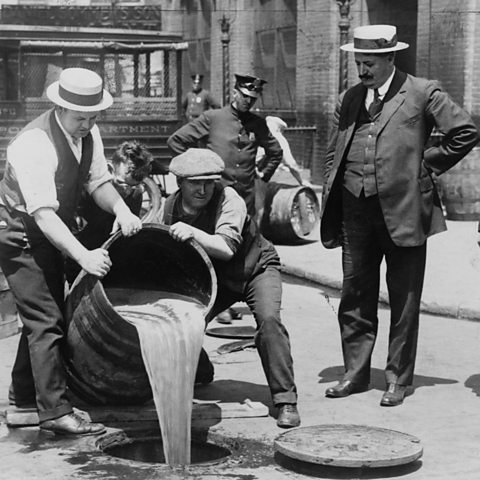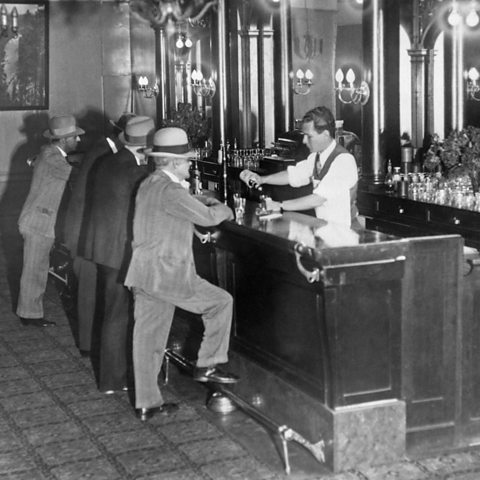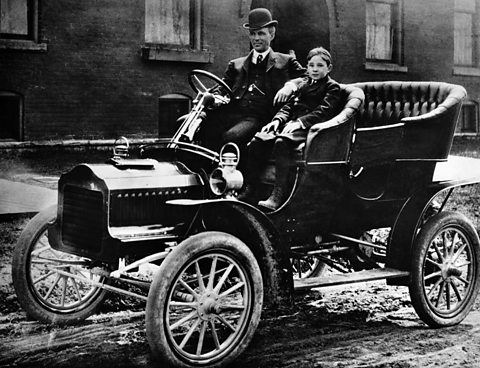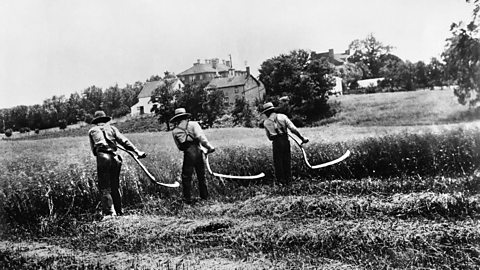Introduction

Before World War One, over half of the states in the USA, especially in the Midwest, had some type of ban on alcohol in their area, with only 13 being completely dry.
Within a few years, the federal government extended Prohibition on alcohol to all states.
On 16 January 1918, the Eighteenth Amendment to the USAâs constitutionRules by which a country is organised and governed. made it illegal to manufacture, transport and sell alcohol in the USA.
The following year, in 1919, the Volstead Act set out the details of what Prohibition meant and the punishments for breaking the new law.
Drinks containing more than 0.5 per cent alcohol were banned.
The aim of Prohibition, also known as âThe Noble Experimentâ, was to stop the trade in alcohol (also known as intoxicating liquor).

Reasons for Prohibition
There was a wide range of economic, political and social reasons for Prohibition.
Pressure from temperance groups and religious groups
Organisations that promoted temperanceRefraining from alcoholic drinks. such as the Anti-Saloon League (ASL) and the Womenâs Christian Temperance Union (WCTU) campaigned hard for Prohibition.
Some religious groups, such as the Methodists and Baptists, joined the crusade.
This was because:
- They saw alcohol as being responsible for crime and violence.
- It threatened families because men wasted their wages on drink and then abused their wives and children.
- It affected peopleâs health.
- It was seen as sinful.
- Preachers, such as Billy Sunday, persuaded many conservativeNot in favour of change, cautious. that alcohol was evil.
Attitude of employers
Businessmen, such as Henry Ford, supported Prohibition because they felt alcohol lessened the efficiency of their workers.
Divisions between brewers and distillers
Brewers refers to beer manufacturers whereas distillers make much stronger spirit drinks such as whiskey.
Brewers argued beer was harmless and spirits were harmful in the hope of deflecting criticism from themselves.
Thus, there was not a united front by the liquor industry against Prohibition.
Patriotism
Most big liquor manufacturers were German, for example Budweiser, and it was seen as unpatriotic (disloyal to the USA) to consume it.
Anti-immigrant beliefs
Many Americans disapproved of immigrantA person who lives in a country they were not born in. because of the prevalence of drinking in their communities, such as the Irish, German and eastern European areas. Anti-immigrant feeling was therefore linked to support for Prohibition.
Political considerations
Politicians, who often drank in private, supported Prohibition in public because they did not want to lose votes in elections, particularly among Christian groups who often cast their vote based upon this issue.
Financial considerations
From 1913, the government in Washington had the power to tax peopleâs incomes. This would make up for the loss of money from taxes on alcohol.
Differing attitudes
Dries
- Those people who supported ProhibitionA name given to a period in US history between 1920-1933 when alcohol was banned. were called âdriesâ.
- They believed alcohol did severe damage to family life, morals, health, the economy and law and order.
- Many of them were from a Christian background, such as the Anti-Saloon League (ASL) and the Womenâs Christian Temperance Union (WCTU), and were genuinely concerned about the impact that alcohol abuse had upon family life.
- The American Medical Association, a group that represented doctors, supported Prohibition on account of the health dangers caused by alcohol.
Wets
- Those people who disliked Prohibition were called âwetsâ.
- They thought that the government was interfering too much in the lives of the individual.
- Drinking was also a popular pastime and a major part of some communitiesâ cultures.
- Unlike the rural communities, there was very little support for Prohibition in the large industrial Northern cities.
- Its manufacture was an important source of employment.
- It also helped farmers because it used up some of their surplusWhen there is more of something than is needed. grain.
The growth and impact of organised crime

Whilst there may have been good intentions behind ProhibitionA name given to a period in US history between 1920-1933 when alcohol was banned. , it faced two major obstacles:
- Millions of Americans still wanted to be able to drink alcohol.
- There were millions of dollars to be made in providing and selling alcohol.
- While providing and selling alcohol was now a crime, it mattered little to the organised criminal gangs who decided to provide ordinary Americans with the alcohol they wanted.
The criminals that produced and sold alcohol were called bootleggers and they sold their product in illegal clubs called speakeasies.
There were 30,000 of these in New York and were often hidden in the back rooms of buildings and shops.
Most of the alcohol came across the Canadian border which was just too vast to police effectively.

Corruption
As the criminal gangs were making so much money they could easily afford to bribe policemen and even judges to ignore their activities.
Therefore, people in public positions did what those bribing them wanted rather than serve the public good.
This is known as corruption.
The mafia
One organised crime network that flourished under prohibition was the Mafia.
This was a Sicilian group based around âcrime familiesâ that operated in the Italian American communities.
They had been involved in activities such as gambling, protection and other so-called âracketsâ, but these were dwarfed by the vast amounts available by providing illegal alcohol.
There were also organised gangs based around the Irish and Jewish communities in New York and Chicago, but the Mafia were the most powerful of all.
Al Capone

Gangs, commonly known as the mob, often used extreme violence against one another in a bid to gain control of racketsThese were illegal schemes set up by members of organised crime gangs to extract money from people or businesses through the threat of violence. and to maintain their secrecy.
The most infamous Mafia leader was 'Scarfaceâ Al Capone.
He controlled the alcohol supply in the city of Chicago and dominated a range of gangs.
He controlled city officials, like judges, through bribery or intimidation.
The most notorious events associated with Capone were âThe St Valentine's Day Massacreâ in 1929, when he ordered the murder of seven of his main rivals, and âThe Last Supperâ, again in 1929, when he personally murdered three Sicilians.
An elite group of incorruptible Prohibition Agents (whose job was to enforce Prohibition), known as The Untouchables and led by Eliot Ness, was assigned to bring Caponeâs bootlegging to an end.
In Chicago, Dion O'Bannion controlled the bootleg business in the south of the city and John Torrio in the north.
The mayor of Chicago, 'Big Bill' Thompson, was under the influence of John Torrio.
OâBannion was killed on the orders of Al Capone.
The city had over 130 gangland murders between 1926 and 1927.
Capone was eventually arrested and jailed in 1931, not for racketeering and murder, but for tax evasion.
This was the only crime that the authorities were certain they could get a conviction on.
There were gangsters in every city.
In New York, the Castellammarese War (a power struggle for control of the mafia), gave organised crime figure, Salvatore Maranzano dominance.
He became âthe boss of bossesâ and established a Mafia code of conduct, which was binding on all members.
Unintentionally, Prohibition had provided the organised crime gangs with their most lucrative racket.
They were so rich and powerful that they became a permanent feature of American life.

Impact
- ProhibitionA name given to a period in US history between 1920-1933 when alcohol was banned. was unpopular and widely ignored. Even President Warren Harding in the White House disregarded it.
- It resulted in thousands of illegal drinking places, known as speakeasyA place that sold alcoholic beverages illegally during Prohibition in the 1920s in the USA., appearing, including at the back of barber shops and hair salons and in basements. Soon, there were more speakeasies, 300,000 in total, than there had been bars before Prohibition.
- It led to illegal bootleggerA person who deals in illicit goods, particularly alcohol., moonshinerTerm given to someone who brews alcohol illegally, this product is often known as 'moonshine'. and rum-runnerTerm given to a person who smuggles or transports alcohol illegally..
- Alcohol-related deaths increased from 98 in 1920 to 760 in 1926. ±«Óătvmade alcohol called moonshine often caused death because either it was too strong or it was contaminated. Industrial alcohol, which had poison added to it to discourage people drinking it, was often stolen and resold for drinking, with fatal consequences.
- Drinking habits changed. There was a shift from beer to spirits because the latter was stronger and less bulky to conceal.
- It led to an increase in corruptionWhen a person in a position of power acts dishonestly in return for money or personal gain.. Bribing of police, judges and politicians was common. Even President Hardingâs advisors were involved.
- Prohibition reduced respect for the law.
- There was an increase in violence and a growth in organised crime.
- It split the Democratic Party. The âdriesâ tended to be from the rural south and west, and the âwetsâ were mostly from urban areas in the north and east.
Reasons for failure
Prohibition may have been well-intended but it was a failure.
- There was a lack of public support. Many people were âwetsâ and it was impossible to persuade drinkers to change the habit of a lifetime. Plus, the law did not forbid the consumption of alcohol (only the manufacture, transport and sale of it), so many felt justified in drinking. President Harding reputedly flouted the law. In addition, non-WASPSomeone who is not a white anglo-saxon protestant (WASP)., especially in the northern states, resented government interfering with their freedoms.
- Alcohol was readily available. It was supplied by bootleggerA person who deals in illicit goods, particularly alcohol., moonshinerTerm given to someone who brews alcohol illegally, this product is often known as 'moonshine'. and rum-runnerTerm given to a person who smuggles or transports alcohol illegally.. There were 280,000 illegal distilleryA place where distilling (a process to separate a substance from a liquid) is done. seized, and speakeasyA place that sold alcoholic beverages illegally during Prohibition in the 1920s in the USA. were everywhere, including 30,000 in New York by 1929. Over ten million medical prescriptions per year were issued for more than one million gallons of beer and the permits for communion wine increased.
- Enforcement of Prohibition by government officials was very ineffective. Patrolling the thousands of miles of the USAâs borders with Canada and Mexico, both major routes for smuggling liquor, was impossible. There were 2,300 special Prohibition Agents appointed by the Prohibition Bureau, but they were too few in numbers and were on low salaries ($2,500 per year) which meant they were prone to corruption. One in twelve agents were sacked for taking bribes. Judges and politicians were also often willing to take bribes.
- Prohibition led to the growth of organised crime gangs, like the Mafia, and gangsters, such as Al Capone. They not only supplied alcohol on a massive scale, but they also ran prostitution, gambling and other rackets. Thus, crime increased dramatically.
- The government were also missing out on some $11billion in lost taxes and many people had lost their jobs in the brewing industry.
The ending of Prohibition
The Twenty-First Amendment to the constitutionRules by which a country is organised and governed. in 1933 ended Prohibition.
Prohibition had proved unenforceable and had led to the growth of organised crime and political corruption.
It seemed that if Americans wanted a drink, they could find a way to do so.
The government accepted that it was better this was done legally with proper safety regulations in place than leave it in the hands of the mobsters.
Quiz: Find the answer in the image
Test your knowledge
More on Life in the United States of America, 1920-33
Find out more by working through a topic
- count6 of 9

- count7 of 9

- count8 of 9
